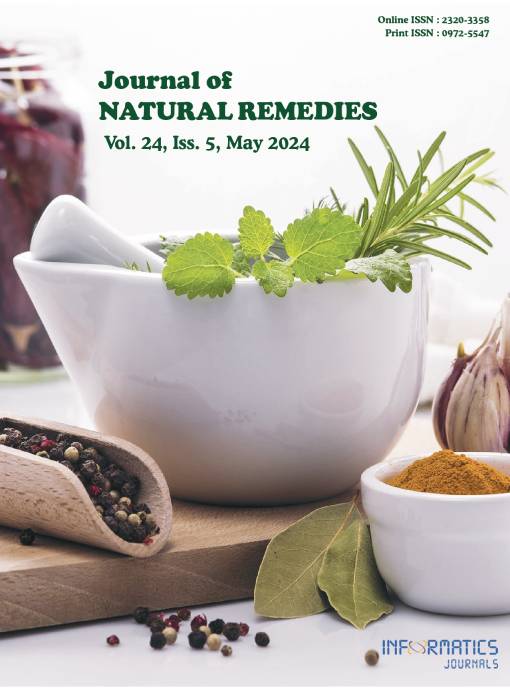In Silico Screening of Phytochemicals as an Approach against Tubulin Inhibitor in Prostate Cancer
DOI:
https://doi.org/10.18311/jnr/2024/34830Keywords:
Docking, In Silico, NPACT, Prostate Cancer, Tubulin, Virtual ScreeningAbstract
Background: Millions of men worldwide are affected by the complicated disease of prostate cancer, which is most common in areas with high socioeconomic indices. There is growing proof indicating that not all cases of prostate tumors are the same as well as that monitoring techniques and prostate-specific localization therapies are harmless methods of dealing with this mild illness. Plant-based chemicals are believed to be an important reservoir of novel bioactive compounds with a range of different chemical motifs. Aim: The potential of tubulin-targeting medications to target Micro tubulin mechanisms and disrupt important cellular processes which include mitosis, cell signalling, cytoplasmic trafficking and angiogenesis is what makes them such effective cancer therapies. Methods: The current research uses a variety of applications for emphasizing the drug-like properties, toxicology testing, and in silico analysis of numerous phytochemicals in prostate cancer by using the NPACT (Naturally occurring plant-based anti-cancer compound) data bank, Auto dock, Biovia discovery studio for the preparation of target protein and interaction between targeted protein site and Phytocompounds. Result and Conclusion: outcomes of the in silico screening, such as the discovery of possible bioactive substances or interested targets. The nine phytochemicals exhibited the greatest docking results, proving they are potent inhibitors of prostate tumors. To verify the computational results, compare the in silico assumptions with empirical information or previously published literature. To reinforce the conclusions, illustrations such as modifications to conformation, binding ways, or sequences of interactions. This in silico study is a critical first step in realizing the enormous promise of plant-based constituents in the field of drugs.
Downloads
Metrics
Downloads
Published
How to Cite
Issue
Section
License
Copyright (c) 2024 Alamas Shaikh, Pinkal Patel, Sachin Kumar Sharma, Adarsh Jha, Isha Parmar (Author)

This work is licensed under a Creative Commons Attribution 4.0 International License.
Accepted 2024-02-27
Published 2024-05-01
References
Parmar G, Shah A, Shah S, Seth AK. Identification of bioactive phytoconstituents from the plant Euphorbia hirta as a potential inhibitor of SARS-CoV-2: An in silico approach. Bio Interface Res Appl Chem. 2022; 12:1385-96. https://doi.org/10.33263/BRIAC122.13851396
Shah A, Patel V, Parmar G. Nanotherapeutics of phyto antioxidants in cancer. Phyto antioxidants and Nanotherapeutics. 2022. p. 495-519. https://doi.org/10.1002/9781119811794.ch22
Adams, J. The case of scirrhous of the prostate gland with the corresponding affliction of the lymphatic glands in the lumbar region and the pelvis. Lancet. 1853; 1:393.
Huggins C, Stephens RC, Hodges CV. Studies on prostatic cancer: 2. The effects of castration on advanced carcinoma of the prostate gland. Arch Surg. 1941; 43:209. https://doi.org/10.1001/archsurg.1941.01210140043004
Palmer JF. (ed.) The Works of John Hunter F. R. S. with Notes (Longman, London). 1837.
Veterans Administration Cooperative Urological Research Group. Treatment and survival of patients with cancer of the prostate. Surg Gynecol Obstet. 1967; 124:1011.
Schally AV, Kastin AJ, Arimura A. Hypothalamic FSH and LH-regulating hormone. Structure, physiology, and clinical studies. Fertil Sterile. 1971; 22:703–21. https://doi.org/10.1016/S0015-0282(16)38580-6
Schally AV, et al. Peptide analogs in the therapy of prostate cancer. Prostate. 2000; 45:158–66. https://doi.org/10.1002/1097-0045(20001001)45:2<158::AID-PROS10>3.0.CO;2-K
Anonymous. Leuprolide versus diethylstilbesterol for metastatic prostate cancer. The Leuprolide Study Group. N Engl J Med. 1984; 311:1281–6. https://doi.org/10.1056/NEJM198411153112004
Vilchez-Martinez JA, Pedroza E, Arimura A, Schally AV. Paradoxical effects of D-Trp6-luteinizing hormone-releasing hormone on the hypothalamic-pituitary-gonadal axis in immature female rats. Fertil Steril. 1979; 31:677–82. https://doi.org/10.1016/S0015-0282(16)44061-6
Denmead SR, Isaacs JT. Cancer Medicine 5th edn (eds Bast RC et al.) B. C. Decker, Inc., Hamilton, Ontario. 2000. p. 765–776.
Jordan MA, Wilson L. Microtubules as a target for anticancer drugs. Nat Rev Cancer. 2004; 4(4):253–65. https://doi.org/10.1038/nrc1317
Peters C, Brown S. Antibody–drug conjugates as novel anti-cancer chemotherapeutics. Bioscience Reports. 2015; 35(4):e00225. https://doi.org/10.1042/BSR20150089
Shah A, Seth AK. In silico identification of novel flavonoids targeting epidermal growth factor receptor. Current Drug Discovery Technologies. 2021; 18(1):75-82. https://doi.org/10.2174/1570163816666191023102112
Brouhard GJ, Rice LM. Microtubule dynamics: an interplay of biochemistry and mechanics. Nat Rev Mol Cell Biol. 2018; 19(7):451–63. https://doi.org/10.1038/s41580-018-0009-y
Desai A, Mitchison TJ. Microtubule polymerization dynamics. Annu Rev Cell Dev Biol. 1997; 13:83. https://doi.org/10.1146/annurev.cellbio.13.1.83
Shah A, Patel V, Parmar G. Nanotherapeutics of Phyto antioxidants in Cancer. Phyto Antioxidants and Nanotherapeutics. 2022. p. 495-519. https://doi.org/10.1002/9781119811794.ch22
Nogales E, Wolf SG, Downing KH. Erratum: Structure of the αβ tubulin dimer by electron crystallography. Nature. 1998; 393(6681):191. https://doi.org/10.1038/30288
Jain M, Anand A, Shah A. Exploring the potential role of theaflavin-3, 3′-digallate in inhibiting various stages of SARS-CoV-2 life cycle: an in silico approach. Chemistry Africa. 2022; 5(4):883-98. https://doi.org/10.1007/s42250-022-00376-7
Shah A, Parmar G, Seth AK. In silico discovery of novel flavonoids as Poly ADP Ribose Polymerase (PARP) Inhibitors. Current Computer-Aided Drug Design. 2021; 17(3):344-50. https://doi.org/10.2174/1573409916666200408082858
Parmar G, Shah A, Shah S, Seth AK. Identification of bioactive phytoconstituents from the plant Euphorbia hirta as a potential inhibitor of SARS-CoV-2: an in silico approach. Bio Interface Res Appl Chem. 2022; 12:1385-96. https://doi.org/10.33263/BRIAC122.13851396
Shah AP, Parmar BM, Ghodawala MA, Seth A. In silico drug discovery of novel small lead compounds targeting Nipah virus attachment glycoprotein. J Integr Health Sci. 2018; 6(2):60. https://doi.org/10.4103/JIHS.JIHS2118
Shah AP, Parmar GR, Sailor GU, Seth AK. Antimalarial phytochemicals identification from Euphorbia hirta against plasmepsin protease: an in silico approach. Folia Medica. 2019; 61(4):584-93. https://doi.org/10.3897/folmed.61.e47965
Shah A, Jain M. Limitations and future challenges of computer-aided drug design methods. In Computer Aided Drug Design (CADD): from ligand-based methods to structure-based approaches. Elsevier. 2022. p. 283-97. https://doi.org/10.1016/B978-0-323-90608-1.00006-X

 Alamas Shaikh
Alamas Shaikh









 0.35
0.35 24
24 0.161
0.161